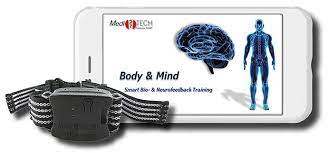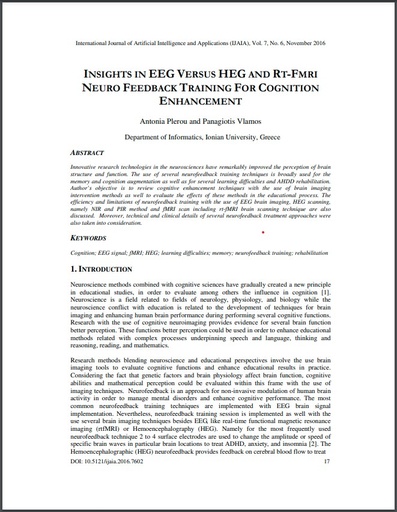
HEG Neurofeedback info channel
Here you will find basic information about HEG neurofeedback. This is a procedure for self-regulation. Unlike conventional EEG neurofeedback, which requires a high degree of self-discipline and especially "sitting still" from the trainee, HEG is extremely easy to use, does not require any pre- and post-processing and is easy for the trainee to understand in its feedback effect.
| Responsible | Ralph Warnke |
|---|---|
| Last Update | 08/13/2024 |
| Completion Time | 1 day 1 hour 35 minutes |
| Mitglieder | 11 |
Share This Course
Share Link
Share on Social Media
Share by Email
Please login to share this HEG Neurofeedback info channel by email.

Innovative research technologies in the neurosciences have remarkably improved the perception of brain structure and function. The use of several neurofeedback training techniques is broadly used for the memory and cognition augmentation as well as for several learning difficulties and AHDD rehabilitation. Author’s objective is to review cognitive enhancement techniques with the use of brain imaging intervention methods as well to evaluate the effects of these methods in the educational process. The efficiency and limitations of neurofeedback training with the use of EEG brain imaging, HEG scanning, namely NIR and PIR method and fMRI scan including rt-fMRI brain scanning technique are also discussed. Moreover, technical and clinical details of several neurofeedback treatment approaches were also taken into consideration.
Publikationen
View allInnovative research technologies in the neurosciences have remarkably improved the perception of brain structure and function. The use of several neurofeedback training techniques is broadly used for the memory and cognition augmentation as well as for several learning difficulties and AHDD rehabilitation. Author’s objective is to review cognitive enhancement techniques with the use of brain imaging intervention methods as well to evaluate the effects of these methods in the educational process. The efficiency and limitations of neurofeedback training with the use of EEG brain imaging, HEG scanning, namely NIR and PIR method and fMRI scan including rt-fMRI brain scanning technique are also discussed. Moreover, technical and clinical details of several neurofeedback treatment approaches were also taken into consideration.
The effectiveness of bio/neurofeedback for ADD and ADHD and similar problems has been proven for a long time. While the previously used technique of neurofeedback is very time-consuming, both in the application and in learning the interpretation of the measured parameters, and also very prone to interference, HEG Feedback offers a revolutionary training opportunity.
Background: The effects of electroencephalography (EEG) and functional magnetic resonance imaging (fMRI)-neurofeedback on brain activation and behaviors have been studied extensively in the past. More recently, researchers have begun to investigate the effects of functional near-infrared spectroscopy-based neurofeedback (fNIRS-neurofeedback). FNIRS is a functional neuroimaging technique based on brain hemodynamics, which is easy to use, portable, inexpensive, and has reduced sensitivity to movement artifacts.
Method: We provide the first systematic review and database of fNIRS-neurofeedback studies, synthesizing findings from 22 peer-reviewed studies (including a total of N = 441 participants; 337 healthy, 104 patients). We (1) give a comprehensive overview of how fNIRS-neurofeedback training protocols were implemented, (2) review the online signal-processing methods used, (3) evaluate the quality of studies using pre-set methodological and reporting quality criteria and also present statistical sensitivity/power analyses, (4) investigate the effectiveness of fNIRS-neurofeedback in modulating brain activation, and (5) review its effectiveness in changing behavior in healthy and pathological populations.
Results and discussion: (1–2) Published studies are heterogeneous (e.g., neurofeedback targets, investigated populations, applied training protocols, and methods). (3) Large randomized controlled trials are still lacking. In view of the novelty of the field, the quality of the published studies is moderate. We identified room for improvement in reporting important information and statistical power to detect realistic effects. (4) Several studies show that people can regulate hemodynamic signals from cortical brain regions with fNIRS-neurofeedback and (5) these studies indicate the feasibility of modulating motor control and prefrontal brain functioning in healthy participants and ameliorating symptoms in clinical populations (stroke, ADHD, autism, and social anxiety). However, valid conclusions about specificity or potential clinical utility are premature.
Conclusion: Due to the advantages of practicability and relatively low cost, fNIRS-neurofeedback might provide a suitable and powerful alternative to EEG and fMRI neurofeedback and has great potential for clinical translation of neurofeedback. Together with more rigorous research and reporting practices, further methodological improvements may lead to a more solid understanding of fNIRS-neurofeedback. Future research will benefit from exploiting the advantages of fNIRS, which offers unique opportunities for neurofeedback research.
Aim: Hemoencephalography (HEG) is an emerging procedure for clinical application in attention-deficit hyperactivity disorder and other disorders, regardless of age. It is available to any research group for its relative simplicity and low cost and is a useful tool for assessing prefrontal-dependent functions. Older teenagers pose peculiarities in the prefrontal maturation, and we aim to establish HEG patterns that might have clinical applicability. Methods: The HEG patterns of 70 university students (56 women and 14 men, 21-48 years old, mean 31.84, SD 10.65, standard error of mean 0.31) were compared with those of 59 adolescents - 13-14-year-old secondary education students, 28 females and 31 males. The HEG patterns were obtained in response to the observation of shocking, unpleasant, and pleasant pictures. We use one-way and two-way analysis of variance to disentangle the differences between groups. All effects were analyzed with F-tests. Results: In all cases, university students and adolescents showed a decrease in prefrontal activity, indicative of differences in the emotional inner networks between groups, which are responsible for security-insecurity processing. Compared with university students, adolescents showed statistically significant differences in decreased activity in very unpleasant (shocking) tests that demand increased security-insecurity processing. Adolescents showed lower decrease. In addition, adolescents, compared with university subjects, did not show statistically significantly decreased HEG activity compared with the baseline in very unpleasant tests. Conclusion: Teens showed distinguishable patterns of HEG, which were consistent with the cognitive emotional dysregulation in cognition and emotion interaction, that is, exterior network versus internal network interactions. Disability in regulation (modulation) of emotional response to negative emotional stimuli (fear of insecurity) in adolescence is an indicator of possible future clinical and psychiatric disorders such as depression and anxiety with high incidence of onset at this critical age and frequent comorbidity in attention-deficit hyperactivity disorder. HEG pattern might be a useful marker to define maturation and future possible mental dysfunctions.
OPEN ACCESS
Background: The effects of electroencephalography (EEG) and functional magnetic
resonance imaging (fMRI)-neurofeedback on brain activation and behaviors have
been studied extensively in the past. More recently, researchers have begun to
investigate the effects of functional near-infrared spectroscopy-based neurofeedback
(fNIRS-neurofeedback). FNIRS is a functional neuroimaging technique based on brain
hemodynamics, which is easy to use, portable, inexpensive, and has reduced sensitivity
to movement artifacts.
Method: We provide the first systematic review and database of fNIRS-neurofeedback
studies, synthesizing findings from 22 peer-reviewed studies (including a total of N = 441
participants; 337 healthy, 104 patients). We (1) give a comprehensive overview of
how fNIRS-neurofeedback training protocols were implemented, (2) review the online
signal-processing methods used, (3) evaluate the quality of studies using pre-set
methodological and reporting quality criteria and also present statistical sensitivity/power
analyses, (4) investigate the effectiveness of fNIRS-neurofeedback in modulating
brain activation, and (5) review its effectiveness in changing behavior in healthy and
pathological populations.
Neurofeedback gewinnt als Behandlungsform fortgesetzt an Bedeutung.
Das Spektrum an Behandlungs- und Anwendungsbereichen für Neurofeedback
nimmt ebenfalls stetig zu. Eine der größten Herausforderungen im
Einsatz von Neurofeedback ist die Behandlung von Kindern und Jugendlichen
(insbesondere mit ADS/ADHS), da EEG-basiertes Neurofeedback
leicht durch Artefakte beeinträchtigt werden kann. Ferner ist in diesen Fällen
bei einer typischen Behandlungsfrequenz von einmal wöchentlich eine
etwa ein Jahr währende Behandlung erforderlich, um ADS/ADHS wirksam
zu verbessern.
Diese Veröffentlichung beschreibt einen alternativen Weg der Neurofeedbackbehandlung.
Sie beruht auf dem Konzept nIR-basierten HEG-Neurofeedbacks
nach Toomin et. al. Die primäre Zielgruppe hier besteht aus
Kindern mit ADS/ADHS, Lese-Rechtschreibschwäche oder verwandten
Lernstörungen. Die Autoren untersuchen die Möglichkeiten und Effektivität
eines kompakt ausgestalteten täglichen Trainings über ein bis zwei
Intensivtrainings wochen. Das erklärte Ziel ist es, Kindern und Jugendlichen
mit Konzentrationsschwächen und mangelnder Ausdauer zu einem
Training zu verhelfen, das für sie gut durchführbar und erfolgreich ist, und
zwar in überzeugender und schneller Art und Weise.
Publikation zu HEG Neurofeedback von Christel Kannegießer-Leitner und Ralph Warnke in NeuroConnections 2013